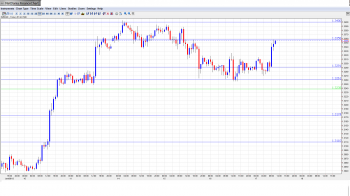After recent losses, EUR/USD bounced back early in Thursday’s European session. The euro had dropped about one cent this week, but has reversed direction, and has climbed into the mid-1.33 range. The euro got some help after positive comments from a senior ECB member. There is only one release out of the Eurozone, as the markets await the publication of the ECB Monthly Bulletin. In the US, it will be a busy day, with three key releases – Building Permits, Unemployment Claims and the Philly Fed Manufacturing Index.
EUR/USD Technical
- Asian session: Euro/dollar was quiet, as the pair touched a high of 1.3315, and consolidated at 1.3297. In the European session, the pair is on the move, and has climbed to 1.3345.
- Current range: 1.3290 to 1.3360.
Further levels in both directions:
- Below: 1.3290, 1.3240, 1.3170, 1.3130, 1.3110, 1,3030, 1.30, 1.2960, 1.2624 and 1.2590.
- Above: 1.3360, 1.34, 1.3480, 1.36, 1.3750 and 1.3838.
- 1.3290 has reverted to a support line. It has strengthened as the pair trades at higher levels.
- On the upside, 1.3360 is providing weak resistance. This line could be tested if the euro continues to push higher.
Euro/dollar gains ground following positive Nowotny comments – click on the graph to enlarge.
EUR/USD Fundamentals
- 9:00 ECB Monthly Bulletin.
- 13:30 US Building Permits. Exp. 0.91M.
- 13:30 US Unemployment Claims. Exp. 369K.
- 13:30 US Housing Starts. Exp. 0.89M.
- 15:00 US Philly Fed Manufacturing Index. Exp. 7.1 points.
For more events and lines, see the Euro to dollar forecast
EUR/USD Sentiment
- Euro bounces back after positive comments: Just a day after the euro dropped following negative remarks by Jean-Paul Juncker, the currency moved higher after another senior ECB official stated the opposite. Juncker, held of the Eurogroup, shook up the markets after bluntly warning that the “euro foreign exchange rate is dangerously high”. The markets jumped on his comments, and the euro quickly headed south, falling below the 1.33 line. On Wednesday, a member of the ECB governing council, Ewald Nowotny, weighed in, stating that the Eurozone situation had shown improvement, and the ECB was not concerned about the recent gains by the euro. These positive sentiments gave a boost to the euro, as it barreled above 1.33. Market players, scrambling to keep up with the latest comments of the day about the value of the euro, must be hoping for more action and less talk from senior ECB officials.
- World Bank lowers global outlook: In a recent report, the World Bank downgraded its forecast for global growth. In its Global Economic Prospects report, which is issued twice a year, the prestigious institution said that global growth in 2013 would be 2.4%. This was down from the 3.0% estimate the World Bank stated in its June 2012 report. The World Bank noted persistent weaknesses in the economies of developed nations, citing austerity measures, high unemployment and weak business confidence. The report also sounded the alarm over the damage in market confidence due the ongoing fiscal battles in the US, and urged a quick resolution of the issue so as to ensure market stability.
- German locomotive losing steam: The once mighty German economy continues to be a source of concern. Recent economic data points to serious trouble in the Eurozone’s largest economy. Trade Surplus dropped to its lowest levels since May, and German Factory Orders fell by 1.2%. German Industrial Production, an important manufacturing indicator, also looked sluggish. For the third straight month, German WPI fell well below the market forecast. If the Eurozone is to get back on its feet later this year, it will need Germany to lead the way.
- Recent US data paints mixed picture: The US released several key indicators on Tuesday, and the picture continues to be good, and bad. Retail sales numbers showed improvement, as both Core Retail Sales and Retail Sales beat their respective estimates. Retail Sales rose 0.5%, hitting a four-month high. These positive numbers were not reflected in manufacturing data, which looked very weak. The Empire State Manufacturing Index dropped -7.8 points, shocking the markets, which had anticipated a gain of 1.9 points. This important index has posted consecutive declines since July, and points to serious weakness in the US manufacturing sector.
- Bernanke Quiet on QE, sends message to Congress: In a speech earlier this week, Fed Reserve Chair Bernard Bernanke may have disappointed some, as he did not give any clues about when the current round of QE might end. Bernanke did little more than express his concern about the speed of the US recovery. He noted that the economy has shown signs of improvement, but he was still unsatisfied with the economy’s progress. Given these sentiments, it seems unlikely that the Fed will consider ending the current round of QE in 2013, barring a spectacular recovery by the US economy during the year. Underscoring this point, the president of the San Francisco Federal Reserve Bank, John Williams, stated that he expected the Fed to continue its bond buying program “well into the second half of 2013.” Although Bernanke avoided talking about QE, he was more forthcoming with regard to the debt ceiling issue, which is likely to be a hot topic, if not a full-blown crisis, in February. The US is quickly approaching its debt limit of $16.4 trillion, and Bernanke said Congress must act and raise the debt ceiling. He further noted that tinkering with interest rates will not make much difference, but that if Congress ensures that the country’s fiscal house is in order, interest rates would gradually rise as the economy improves.

